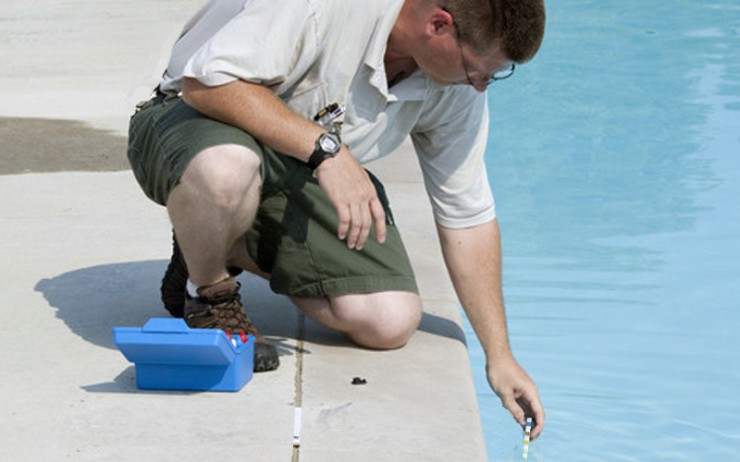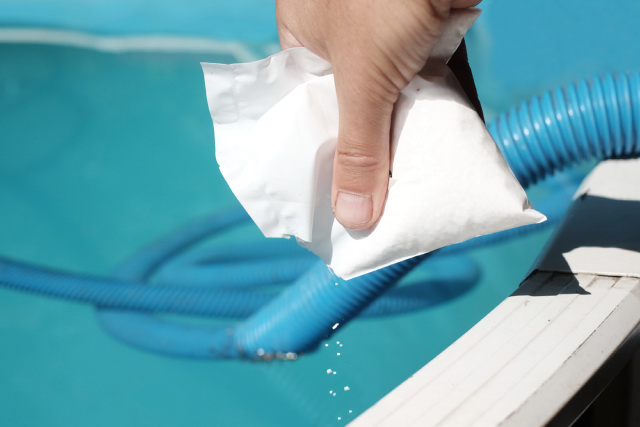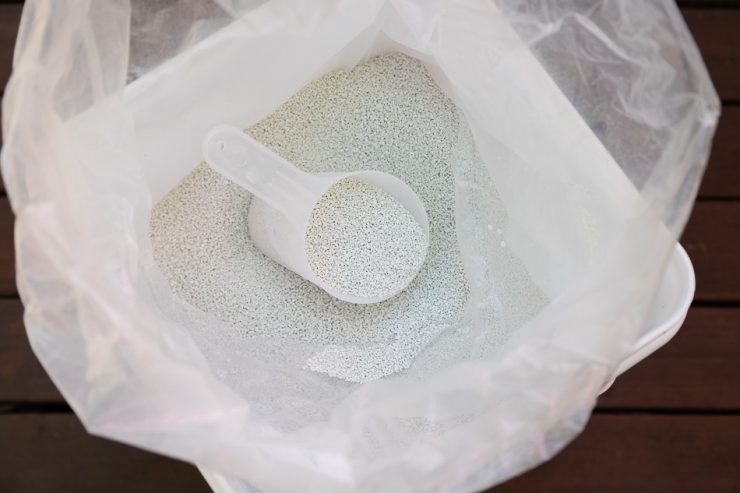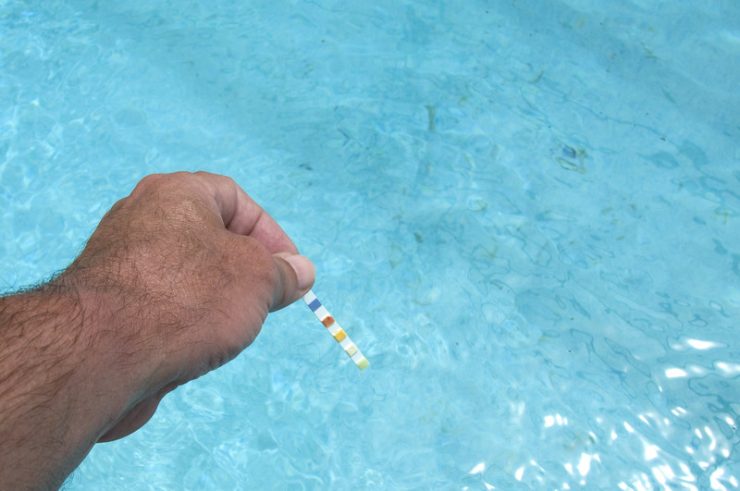Did you just test your pool, and the results showed that total chlorine was high and free chlorine was low? If you are curious about what this means and how to fix it, keep reading to find a solution.

To fix a high level of total chlorine and a low level of free chlorine in your pool, you will need to decrease the amount of combined chlorine and increase the available free chlorine by shocking the pool and balancing the pH, stabilizer, and total alkalinity.
There’s a bit more to it than that, though. Keep reading to find out the exact steps to fix your pool.
Article Contents
How Total Chlorine and Free Chlorine Work
The total chlorine or total available chlorine (TAC) level is the total of how much free chlorine (or Free Available Chlorine – FAC) and combined chlorine (CC) there is in the pool. If you tested the pool water and there was no free chlorine present, or the free chlorine level was low, this indicates that the combined chlorine is too high.
Ideally, you want free chlorine levels to be around 3 ppm for your pool to be sanitized. Combined chlorine levels should be at 0 and never higher than 0.5 ppm, as this would show that there are too many contaminants in the pool water.
You always want free chlorine levels to be higher than the combined ones, so if you see that this is out of balance – do not swim!
Free chlorine (FC) does most of the sanitizing in your pool. And if the FC is low, then your pool may not be sanitized properly.
3 Causes of High Total Chlorine & Low Free Chlorine

Some possible causes of total chlorine high and free chlorine low include:
1. Not Maintaining Chlorine Levels Consistently
If you do not regularly add and maintain your chlorine levels to keep the pool water balanced, it is likely that the pool water will become unhealthy to swim in.
When there are contaminants in your pool, such as sweat and urea from bathers, sunscreen, water run-off from rain, and organics such as leaves, bugs, and bird poop, your chlorine goes to work. All these contaminants “use” up your chlorine.
Meaning you need to continually add fresh chlorine. But if you have many of these contaminants, you will need more chlorine than usual or more than you think.
2. Not Cleaning Your Pool
A build-up of leaves, bugs and other debris in your pool water can cause the number of phosphates in the pool water to increase, causing algae to bloom. There will then be an increase chloramines and combined chlorine in your pool.
3. Too Much Ammonia Has Gotten Into The Pool
If high amounts of ammonia get into the pool water, such as through garden products and deck cleaners, this can increase the consumption of free chlorine, causing low free chlorine levels and high combined chlorine levels.
What to Do If Total Chlorine is High and Free Chlorine is Low
If you’re experiencing high levels of total chlorine in your pool, but the free available chlorine is low (under 3 ppm), you must increase the free chlorine levels. In many cases, this will mean shocking the pool with liquid chlorine or granular pool shock, calcium hypochlorite (cal-hypo).
If you’ve already added a little chlorine but not shocked and are finding that your free chlorine isn’t increasing, it’s usually because you have high chlorine demand or chlorine lock. If this is the case, you’ll need lots of chlorine. About 5 – 10 times the normal level.
High chlorine demand is caused by the following:
- Algae (sometimes you can’t see it, but it’s there)
- High levels of organics in the water
- Sustained high use of the pool
- Accidents in the water (think poop and wee)
- Pool chemistry out of balance, such as pH and cyanuric acid
Here are the best ways to bring your combined chlorine down and increase the free chlorine.
Fix 1 – Shock or Super Chlorinate the Pool
This is going to be your number one fix.
When you have high chlorine demand and your free chlorine is low, generally, you need a whole lot more chlorine than you think (about 5 – 10 times normal levels). And you may need to use other methods, such as shocking the pool, which is essentially just bombarding your pool with chlorine, to increase the free chlorine.
You can use pool shock (calcium hypochlorite) or sodium hypochlorite (liquid chlorine or bleach) to do this. Don’t use a stabilized chlorine though, as you’ll end up with excessive stabilizer in the water.
Before super chlorinating (shocking) the pool, ensure the pH is around 7.4 – 7.6, and cyanuric acid levels are around 30 – 60 ppm. This will ensure any chlorine or shock you add is at its most effective.
Here’s an effective pool shock you can use:
- Powerful pool chlorine/shock treatment - great for killing algae & everyday chlorination.
- It can be used in all pools & doesn't raise stabilizer levels
- Clears cloudy & dull water
How Much Shock to Use if Total Chlorine is High and Free Chlorine is Low?

If you are shocking a pool experiencing high chlorine demand, you will need around 1 – 4 pounds of shock per 10,000 gallons of pool water. Be sure to read the instructions on the specific product you are using, but keep in mind it’s OK to use twice the amount or even triple or more.
If you have a saltwater pool, stick with liquid chlorine for a shock as you don’t want to add calcium to a saltwater pool. Calcium hypochlorite (or granular pool shock) adds unwanted calcium to the water.
When you do shock the pool, you may need to maintain high levels of chlorine, 5-10 times the norm, for a few days to kill off all the contaminants.
Do not swim in your pool until the chlorine levels have decreased and are back in balance! Chlorine levels will naturally decrease if you leave the pool for a few days without adding chlorine.
Fix 2 – Add a Phosphate Remover
Phosphates are a source of food for algae. If you have high levels of phosphates in your pool, chances are the total chlorine levels are high, and free chlorine is low. Using a phosphate remover may help to decrease the chlorine demand and cause all your free chlorine levels to increase again.
Here’s a phosphate remover:
- Controls & eliminates phosphates in spas and hot tubs
- Works in most pool water but ideal for spa saltwater systems
- Protects against calcium phosphate scale build ups
Fix 3 – Balance the Chemistry
As we’ve already mentioned, it’s super important the other chemistry in your pool is at the right levels. The main things you want to take care of are:
- pH
- Stabilizer (cyanuric acid)
- Total alkalinity
If the pH is high, the chlorine will not work as effectively. Add some acid to your water, such as muriatic acid, hydrochloric acid, or sodium bisulfate (pH down or ph decreased).
High levels of stabilizer also cause chlorine to be ineffective. Keep the levels at 30-50 ppm. The only way to reduce it is by diluting it. You can achieve this by topping up the pool with water, or if the pool is already full, drain a little water, say 10-15%, then top up with fresh water.
Conversely, not enough stabilizers in the water will cause your chlorine to be burnt off by the sun. Add cyanuric acid or stabilizer directly to the pool to increase the stabilizer (CYA or cyanuric acid).
Adding stabilized chlorine such as dichlor and trichlor will also increase the stabilizer levels in the pool, but much more slowly. Adding cyanuric acid as a stand-alone product is the fastest way to increase the stabilizer levels.
Finally, you want to ensure total alkalinity levels are correct. This is very closely linked to pH. When you change one, the other changes. Use acid and baking soda to adjust the alkalinity, down and up respectively.
How To Test Total Chlorine Levels

Testing chlorine levels in your pool is something all pool owners must do! You should be testing your pool water around 2-3 times a week, especially during the summer when it is getting a lot of use.
Let’s dive into the best products to test your chlorine levels and go through the process of how to use them.
Best Products To Test Total Chlorine
The 2 most popular ways to test your chlorine levels are a test strip or a liquid test kit. Remember that not all test kits measure total chlorine and free chlorine.
Pool Test Strips
- 7-in-1 Test: chlorine, bromine, pH, cyanuric acid, & more
- For pools and spas
- Quick and easy
Using a test strip to test your pool’s chlorine levels is:
- Very simple and easy to use! Just dip it in the water for a few seconds and watch the strip change color.
- Super affordable. Costing around USD $8 – $20 for a pack of approx 150 strips.
- Tests levels for a range of things such as pH and alkalinity – not only chlorine
- Not very accurate
Liquid or DPD Test Kits
- Tests free and total chlorine
- Extremely accurate and reliable
- Tells you if you need to shock pool
Using a liquid test kit (also called a drop test kit) to test your pool’s chlorine levels is:
- Known to be far more accurate compared to test strips
- Easy and safe method
- Only takes around 5 – 10 minutes to test
- Tests for a variety of things
- Generally costs around USD $20 – $200
Steps To Measure Total Chlorine Levels
Testing Total Chlorine Levels Using a Test Strip
- Dip the test strip into the pool water for around 5 seconds
- Take it out and wait for about 10-15 seconds while the strip changes color
- Compare the results with the chart you are provided with your test strips
- Adjust the chlorine levels accordingly based on the results
- Run the pump in the pool and let the new chlorine disperse
- Check the chlorine levels again the next day (or after at least 6 hours). If the chlorine levels are looking balanced, great! If not, try again.
Testing Total Chlorine Levels Using a Liquid Test Kit
- Take a water sample from the pool using the sample tube provided
- Follow the instructions on your specific kit about adding the drops of the chemicals provided into the water sample
- Wait while the water color changes
- Match the water color to the color chart to determine the results
- Adjust the chlorine levels accordingly based on the results
- Run the pool pump, wait until the next day (or at least 6 hours), and retest.
Frequently Asked Questions
Is it Safe to Swim With High Total Chlorine & Low Free Chlorine?
If the total chlorine levels are high due to the combined chlorine being too high or, alternatively, the free chlorine levels being too high, you want to avoid swimming in the pool.
Swimming in a pool with high combined chlorine is bad for your health, as the water will not be sanitized enough. Swimming in a pool with very high free chlorine levels is also bad, as it can cause skin irritation and even chlorine poisoning in extreme cases.
Can You Swim If Total Chlorine is Low?
If the total chlorine levels are low due to an inadequate amount of free chlorine, swimming is not recommended as the pool water will not be sanitized enough, and more chlorine needs to be added.
What It Means If Total Chlorine is High and Everything Else is Ok
If the total chlorine level is high, but the free chlorine level and combined levels are okay, then recheck your results. Total chlorine is the sum of free chlorine and combined chlorine.
That is, if free chlorine is correct and combined chlorine is low, total chlorine should be at the right level. It’s only if free chlorine is high, combined chlorine is high, or both are high that total chlorine will be high.






Hi, can I ask a ? My free chlorine 2.68, total chlorine 2.95, PH 8.1, cyanuric acid 63, total alkalinity is 73, what I have to fix first and how please help, thanks.
You’ll need to get your pH under control. It should be 7.4-7.6. You can use muriatic acid, hydrochloric acid or sodium bisulfate to achieve this. Check out our article How to Lower the pH in your Pool. After this, you can add some more chlorine.